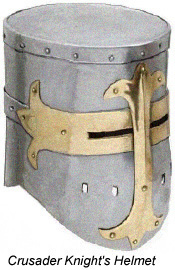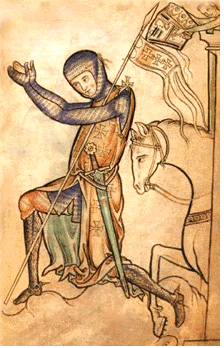...Best of Sicily presents... Best of Sicily Magazine. ... Dedicated to Sicilian art, culture, history, people, places and all things Sicilian. |
by Luigi Mendola | |||
Magazine Index Best of Sicily Arts & Culture Fashion Food & Wine History & Society About Us Travel Faqs Contact Map of Sicily
|
Later Crusades took European expeditions of knights to Tunisia and Turkey, and a series of sea battles against pirates and the Ottoman Turks during the sixteenth century are sometimes referred to as "crusades." So were the Reconquista wars against the Muslims in Spain. The infamous Albigensian Crusade (of 1209) sought to reform or eliminate the heretical Cathars in southern France and the wars of the Teutonic Order against the Slavic and Baltic peoples are sometimes called the "Northern Crusades." Over time, any military campaign called by a Pope came to be defined as a crusade, so in 1284, when Pope Martin IV declared "holy war" against Peter of Aragon (who became King of Sicily with the War of the Vespers in 1282), the subsequent debacle became known as the "Aragonese Crusade." For our purposes, the word Crusade refers to organised Christian expeditions against Muslims before 1300. To glance at the map, one might expect the Kingdom of Sicily, poised along a kind of Christian frontier, to have lent particularly great support to the Crusading Movement. Such a supposition would be mistaken. While its geography inevitably linked Sicily to the Crusades and the crusading military-religious orders (Hospitallers, Templars and Teutonic Knights) were present on the island, Sicilians themselves rarely participated either as combatants or pilgrims. Though this position bears explanation, its basis will be comprehensible to anybody familiar with the multicultural climate that existed in Sicily from around 1060 until circa 1270. As we shall see, the single crusade led by a Sicilian King, Frederick II, was a military campaign in name only. Led by Bohemond of Taranto, a number of Norman knights participated in the First Crusade, launched in 1095. These Normans were part of the so-called "Frankish" contingent. (The word Frank came to refer to many of the "Western" peoples of twelfth-century Europe, not only the French and Germans.) Among Italo-Norman lords, Bohemond's escapade was an isolated case. His uncle, Count Roger of Sicily, ruled a polyglot kingdom where Muslims were not considered enemies. Over time, Sicily's Norman kings occasionally led expeditions into Muslim territories in Tunisia and the Balkans, but these attempts to control bordering territories and waters cannot be said to have reflected any religious conviction or philosophy. Their scope was mostly military and political. They were not Crusades. Beginning with the Battle of Palermo in 1071, the Normans cultivated what was perhaps medieval Europe's first multicultural society. The Arabs - Muslims comprising around 45% of the island's population - were accommodated, at least initially, and so were the "Byzantines" or Greek "Orthodox" Christians (another 45%) and the Jews (something under 10%). Occurring as they did in the wake of the Great Schism between the Greek "Orthodox" East and the Latin "Catholic" West, the Crusades sometimes embodied ugly sentiments toward the Eastern Christians on the part of the Franks, leading to the bloody Sack of Constantinople - a Christian kingdom - during the Fourth Crusade (1202-1204). Amidst such religious zeal, attitudes toward Jews were not always much more enlightened. Such religious intolerance was generally unwelcome in Sicily. Indeed, there are few records - or indications of any kind - attesting to any significant number of Sicilian knights of the Norman era (circa 1060-1200) "taking up the Cross" and going on Crusade, a fact that contrasts sharply with the situation in Norman England during the same period. This may seem difficult to reconcile with the existence of the military-religious orders in Sicily, but these orders established a solid presence in Sicily only during the "Swabian" era around 1200, which is to say during the reigns of the Holy Roman Emperors Henry VI and his son Frederick II. In stark contrast to their economic power in France and England (the Templars come to mind), the military-religious orders in the Kingdom of Sicily - Europe's wealthiest realm - were kept firmly under control. In Sicily the Templars, Teutonic Knights and Hospitallers were never allowed to forget that they were guests, and King Roger II had little use for the Crusades. Which Crusades touched Sicily? Speaking literally, the important port city of Messina was often a springboard for the crusaders who chose a sea route over a land route across the Balkans and Greece. It is important to remember, of course, that most of the Italian peninsula south of Rome was part of the Kingdom of Sicily, so a departure from Brindisi or Taranto (in Apulia) would also be undertaken from "Sicily."
This "Mother of All Crusades," led by Godfrey of Bouillon, Baldwin of Flanders, Raymond of Toulouse, Robert of Normandy and Bohemond of Taranto, marched south through Anatolia. It is interesting that Jerusalem's Muslims and Jews joined forces against the invading Franks. Launched in 1147, the Second Crusade was a response to the re-conquest of certain territories by the Muslims, particularly Edessa. This Crusade by French and German armies, under Louis VII and Conrad III, reached Jerusalem in 1147 but without having won any major battles. The Third Crusade (1187-1192) was a response to the Muslim occupation of most of the territory gained by the Christians nearly a century earlier. This found the colourful King Richard I "Lionheart" with King Philip II Augustus of France in Messina en route to Palestine to fight the formidable Saladin. (Richard's exploits in Sicily are described elsewhere.) On this occasion, the population of Messina was molested and attacked by the foreign troops, and King Tancred of Sicily, whose power was contested by the Pope and others, had to seek peace with Lionheart. The Third Crusade was a failure in that it did not lead to Christian control of Jerusalem, but Richard did capture the city of Acre and the island of Cyprus (which remained in Christian hands until 1571). Begun in 1202, the poorly organised Fourth Crusade is infamously remembered for the sack of Constantinople. The ridiculous Children's Crusade of 1212 was also a debacle. The Fifth Crusade (1217-1221), though a military failure, led to an eight-year peace with the Europeans and Christian access to the Holy Places. The Sixth Crusade (1228-1229) was the only one led by a Sicilian king, Emperor Frederick II, despite being excommunicated by Pope Gregory IX in 1228. Federick set sail from Brindisi, while some ships departed from Messina. By now, with most of Sicily's Muslims converted to Christianity, Sicilian knights participated in the Crusade. In the Holy Land Frederick signed a peace treaty with the sultan Al-Kamil. This pact permitted Christians - with Frederick as King of Jerusalem by virtue of his marriage to the young heiress Yolanda - control over most of the city of Jerusalem as well as corridor between this "Holy City" and the military stronghold of Acre. Though granting freedom of access to Christians and Jews, the Muslims kept control over high ground that included the Dome of the Rock, the Al-Aqsa Mosque and the Church of the Holy Sepulchre. This parlous peace lasted for all of a decade. Most of the Muslims were never happy with Al-Kamil relinquishing control of Jerusalem. In 1244, following a siege of the city, the Muslims seized control. Frederick's dynasty did not long survive him, and by 1268 a branch of the Angevin dynasty of France ruled Sicily from Naples. In 1270, when his younger brother Charles was King of Naples and Sicily, King Louis IX of France (later canonised as Saint Louis) led a Crusade to Tunisia, having previously undertaken a disastrous one to Egypt. This is usually called the Tunisian Crusade. It achieved little except to establish favourable trading rights in Tunis. Louis died (probably of dysentery) and was given a funeral in the Cathedral of Monreale overlooking Palermo, where his heart is kept. His son and heir, Philip III, returned to France following the Sicilian coast to Messina and crossed into Calabria where his pregnant wife fell from a horse and died whle crossing a stream outside Cosenza. Louis' brother, Charles, eventually lost the Sicilian throne during the War of the Vespers in 1282, and the "Aragonese Crusade" against his rival, Peter of Aragon, met with even less success than most of the Crusades to the Holy Land. During the sixteenth century, Charles V revived something of the "crusading tradition" through his exploits in Tunisia and his support of the Hospitallers ("Knights of Malta") as a bulwark against the Ottoman Turks, but in truth crusading died with Saint Louis. Despite much effort, the Crusades had little lasting effect in Europe. Sicily's Norman-Arab churches and palaces resemble many of the churches and castles erected in the eastern Mediterranean during the Crusade era.
About the Author: Historian Luigi Mendola has written for various publications, including this one. | ||
Top of Page |
 Undertaken in an
era of widespread religious fervour, the Crusades were a series
of wars launched by medieval European Christians to reclaim from Muslim
control various regions along the eastern and southern Mediterranean. Sanctioned
by the Popes beginning in 1095, the first Crusades sought to occupy the
Holy Land, comprising parts of what are now Israel, Lebanon, Syria, Jordan
and north-eastern Egypt. Immediately prior to the great Muslim-Arab expansion,
the greater portion of this territory had been part of the
(christianised) Byzantine Empire ruled from Constantinople. In that respect, the history of the region was not unlike
that of Byzantine Sicily before the Arab incursions onto the island beginning in 827; the Muslims had
taken Jerusalem from the Byzantines in 637. Jerusalem, of course, was a special objective of the Crusaders.
Undertaken in an
era of widespread religious fervour, the Crusades were a series
of wars launched by medieval European Christians to reclaim from Muslim
control various regions along the eastern and southern Mediterranean. Sanctioned
by the Popes beginning in 1095, the first Crusades sought to occupy the
Holy Land, comprising parts of what are now Israel, Lebanon, Syria, Jordan
and north-eastern Egypt. Immediately prior to the great Muslim-Arab expansion,
the greater portion of this territory had been part of the
(christianised) Byzantine Empire ruled from Constantinople. In that respect, the history of the region was not unlike
that of Byzantine Sicily before the Arab incursions onto the island beginning in 827; the Muslims had
taken Jerusalem from the Byzantines in 637. Jerusalem, of course, was a special objective of the Crusaders. A number of Crusaders
passed through Messina during the First Crusade,
which in 1099 led to establishment of a Crusader state in the Holy Land
that came to be known as the "Latin" or "Frankish" Kingdom
of Jerusalem. This state would have much contact with the Kingdom of Sicily,
which - though separated from it by half the Mediterranean - was the nearest
"western" state of any stability. The nobility of the Kingdom
of Jerusalem spoke the same tongue as the
A number of Crusaders
passed through Messina during the First Crusade,
which in 1099 led to establishment of a Crusader state in the Holy Land
that came to be known as the "Latin" or "Frankish" Kingdom
of Jerusalem. This state would have much contact with the Kingdom of Sicily,
which - though separated from it by half the Mediterranean - was the nearest
"western" state of any stability. The nobility of the Kingdom
of Jerusalem spoke the same tongue as the